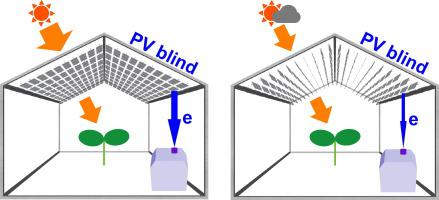Applied Energy ( IF 10.1 ) Pub Date : 2020-09-19 , DOI: 10.1016/j.apenergy.2020.115853 Zhi Li , Akira Yano , Hidekazu Yoshioka

|
The use of renewable energy in modern greenhouse management is important to achieve efficient and sustainable food supplies for a world with increasing population. This study assessed the performance of a blind-type shading regulator that can automatically rotate semi-transparent photovoltaic (PV) blades installed on the greenhouse roof in response to sunlight variation. The PV blind oriented parallel to the roof partially blocked intense sunlight penetration into the greenhouse, but it transmitted sunlight during cloudy time by turning the blind bearing to be perpendicular to the roof. A stable irradiation environment is therefore producible in the greenhouse under variable sky conditions. Annual operations demonstrated that the blinds’ own generated electrical energy can sustain PV blind operation and produce surplus electrical energy. The PV blind electricity generation and sunlight availability for crops below the PV blind roof were calculated based on a mathematical model developed using theoretical sunlight parameters and the experimentally obtained PV blind system parameters. Assuming cloudless skies and threshold irradiance for blind rotation set at 500 W m−2, 13.0 and 12.3 kWh m−2 yr−1 surplus electrical energy can be generated, respectively, by north–south and east–west oriented model greenhouses. Cloudy skies reduce surplus electrical energy production by 50%, but PV blinds can supply greenhouse electrical energy demands partially or completely, depending on the degree of greenhouse electrification. Below the PV blinds, 8–10 MJ m−2 day−1 of insolation is expected to irradiate crops under actual sky conditions. This insolation is sufficient to cultivate major horticultural crops. Regulating the threshold irradiance level for PV blind turning can control the sunlight apportionment ratio for cultivation and electricity generation, thereby enabling sustainable energy–food dual production in a greenhouse.
中文翻译:

设计用于温室中同时生产农作物和电力的盲式光伏屋顶-遮阳系统的可行性研究
在现代温室管理中使用可再生能源对于为人口不断增加的世界实现高效,可持续的粮食供应至关重要。这项研究评估了一种百叶窗型遮阳调节器的性能,该调节器可以根据日光变化自动旋转安装在温室屋顶上的半透明光伏(PV)叶片。平行于屋顶定向的PV百叶窗部分地阻止了强烈的阳光穿透进入温室,但是在阴天时,它通过旋转百叶窗轴承使其垂直于屋顶而透射了阳光。因此在可变的天空条件下在温室中可以产生稳定的辐照环境。年度运营证明,百叶窗自身产生的电能可以维持PV百叶窗运行并产生多余的电能。基于使用理论日照参数和实验获得的PV盲系统参数建立的数学模型,计算了PV盲屋顶下方农作物的PV盲发电量和日光利用率。假设无云的天空和盲旋转的阈值辐照度设置为500 W m-2,13.0和12.3千瓦时米-2年-1可被产生的剩余电能,分别由南北和面向东-西模型温室。多云的天空使过剩的电能产生减少了50%,但是光伏百叶窗可以部分或全部满足温室电能需求,具体取决于温室的电气化程度。光伏百叶窗下方,8-10 MJ m -2天-1预计日照量的多少会在实际的天空条件下照射农作物。这种日照足以种植主要的园艺作物。调节PV盲转的阈值辐照度水平可以控制种植和发电时的阳光分配比例,从而实现温室中可持续的能源-食品双重生产。











































 京公网安备 11010802027423号
京公网安备 11010802027423号